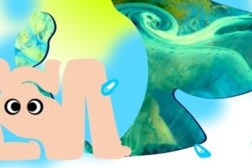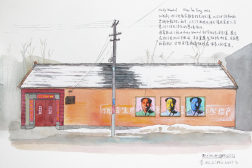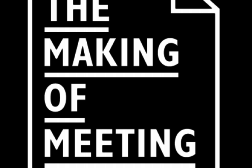A Vision for Expansion: Arthub Asia and Van Abbemuseum
Groundedness and Double Motivations
“Awareness of the importance of working cross culturally has been on the rise and many art activities now privilege cross cultural exchanges, as we face new challenges in cultural diversity, fragmentations and conflicts, both within a common locality and inter-locality.
Yet what are the models of cultural productions that we are falling back on? We can agree on the importance of sharing, exchange and dialogue, as the gap in cultural understanding widens, even as distances between cultures and groups of people collapse in other ways. Yet have we taken time to evaluate how effective our current models of cultural productions are in extending cultural connectivity – in generating new ways of making and sustaining connections between peoples?”
— Chu Chu Yuan, presentation text for the concept of Bureau for Cultural Interconnectivity, August 2006
What is so important about sustaining these connections that Chu Chu Yuan refers to? This, for us, is the key to understanding the Arthub Asia story. We have been working in the cultural world for almost two decades now: from within civil societies, exploring connections between private and public structures, to re-thinking models of cross-cultural models – all with an almost unconscious desire to understand, analyse and interface with Asia. Our experience has meant a constant dialogue with cultural peers, artists and organisations both in Asia and the rest of the world; and we have come to the conclusion that it is difficult to change the mindsets of cross-cultural project facilitators and practitioners who keep re-validating seemingly fixed and unchangeable models.
Once again, in the words of Chu Chuyuan:
“We have inherited many of our current models of cultural knowledge and methodologies (of research, forms of presentation, productions) by inheritance from past histories and hierarchies (e.g. colonisation, foreign education, old institutions) and have not intensively worked on adapting and renewing these models for local conditions and changing times.”
This is utterly true in the Chinese and Asian context where contemporary artistic practices have a short history of structural development and face the problem of “translating” these “cultural knowledge and methodologies.” It is certainly possible to look at various cultural exchanges that took place historically, mostly in modern times if not under colonial shades, and learn from them. Yet the fact is that the various levels of economic and political “ruptures” over time (as in the case of China 1949-mid 1979) mean that in Shanghai, it’s only possible to talk about a contemporary art scene from the mid-90s onwards. For this reason, the decade of groundwork for BizArt (now called Biyi) needs to be better analysed and understood.
The principle of “groundedness” is BizArt’s strength but also became its Achilles’ heel, stunting its growth, leaving it guarded and incestuous. Only much later did the process of building common ground between China and the rest of the world begin (such as the Korean residency that was established at Bizart in 2003, as well as a partnership with UK Artist Links later on), revealing the importance of Bizart-supported artists’ mobility across the globe and the issues of interculturalism and cultural imperialism. Once the organisation’s base was consolidated at a local level, it was time to move out of the box and explore interfaces with the rest of Asia and more broadly. It was only then that Arthub was conceived.
By positioning itself in this fragile yet important niche, Arthub has not only thrived, participating in global knowledge flows and connecting locality with the global picture; but it has also remained vital in facilitating that connection of locality within and to locality, from person to person, mind to mind. Arthub has become a proxy and an experiment, pooling some of Asia’s global authority and asking whether new synergies can be created when select local and global minds are able to freely connect through imagination and creative impulse. As Arthub Directors, we have been responsible for orchestrating this network, encouraging Arthub participants to collaborate with our partners in different capacities (through research, workshops, exhibitions, productions, publications), hoping these groups will gather among themselves in an ad hoc fashion to address both predictable and unexpected challenges, learn from each other and pull in non-visual, art-related fields as needed.
The core questions that Arthub faces are now: How do we further the possibilities within our network and develop models that will carry cultural production into the next decades? What are the aspects that we want to carry forward and leave behind? If we acknowledge the shift from a world where the key advantage was in protecting knowledge within a given set of “knowledge stocks” into a world where participation in the flow of knowledge becomes more valuable, then how can we effectively link ourselves with more engaged and inspired partners we see as actively creating, producing, renewing or possessing new knowledge?
Our decision to work with the Van Abbemuseum in the context of this exhibition was part of the answer to these questions. The Van Abbemuseum proved to be a rewarding partner for Arthub, though we made a strange pair: an established museum institution and a very simply structured, three-person operation (Defne Ayas, Davide Quadrio and Qiu Zhijie). The two curatorial teams aimed to actualize a static “transportation” of cultural objects (from the Van Abbemuseum collection) into a dynamic process where the locality (artists and thinkers not only “ethnically” Chinese but working in Shanghai and China) will re-contextualize, interpret and critique the core idea of “exchange”, revealing how this very word is most often misused or the tool of an imperialist agenda. The process has been one of constant negotiation: is it possible for both parties to be involved in a cross-cultural artistic and institutional production of substance, which goes beyond the simplicity of the occasion, the World Expo 2010?
Double Infinity marks the first time that a museum opens itself and its permanent collection up to the dynamic responses and contributions of artists and artist collectives in China, where usually exhibitions and collections are “moved” in and out of the country without a deep connection to the needs of the local scene. We consider this to be quite a significant gesture and believe that our joint planning and discussion process over the last two years could provide a template for an innovative way to work in China. The issues surrounding cultural exchange in the 21st century and contemporary flows of knowledge will indeed be the focus of a number of invited contributors from around Asia, who will participate in our month of programming around the exhibition itself. This, for us, is the key to our own production of knowledge and a means to short circuiting other prospective institutional models usually deemed appropriate for China when engaging with the “West.”
We know that to thrive as Arthub Asia in a new century we need to seek out further meaningful collaborations by enabling a greater number of the region’s independent thinkers to participate in global knowledge flows, beyond the boundaries of the established art world. The future belongs to those who promote richer and ever more diverse exchange in the truest sense and form the practices required to harness the outcomes. Since its inception, Arthub has been convinced that this is indeed possible and we hope this project, Double Infinity will push the boundaries between institutional approach and civil society, hands-on “groundedness.” This is what our work aims to achieve and the results are there for all to see.
Defne Ayas and Davide Quadrio
Shanghai and Bangkok, February 2010



